One of the most beautiful breeds of Columbidae, the Nicobar pigeon is the only remaining living member of the genus Caleonas.
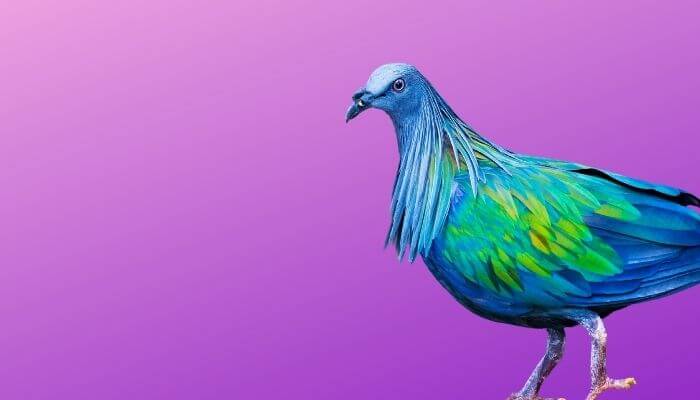
This might not mean anything to a casual bird lover, but it means that the Nicobar pigeon is believed to be the closest living relative of the dodo, the extinct bird that has come to be a symbol of extinct animals all over the world.
The Nicobar pigeon is also believed to be connected to the similarly extinct Rodrigues solitaire.
If this information has piqued your interest and you want to know more about this unique bird, then you have come to the right place!
Origins of the Nicobar Pigeon
Although also known as the vulturine pigeon, hackled pigeon, or white-tailed pigeon, the Nicobar pigeon, as the name suggests, originated in the Islands of Nicobar.
These islands are a union territory of India along with the Andaman Islands (home of the rare Andaman wood pigeon) and lie in the eastern Indian Ocean.
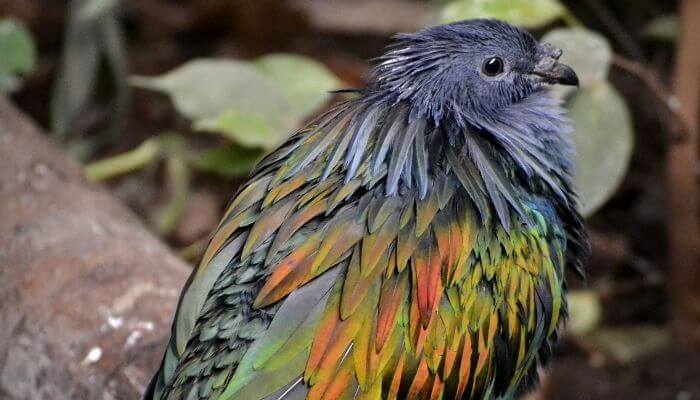
An island that is designated one of the World Network of Heritage Biospheres, it lies 1,300 km southeast of the Indian subcontinent and 150 miles north of the Indonesian island of Sumatra.
Originally, there were two very similar but still genetically different breeds, the Nicobar and Spotted Green Pigeon (described in 1783) and tests have revealed their close links to other members of the Raphinae family (that includes the dodo) but only the Nicobar survives today.
Distribution And Habitat
The Nicobar pigeon is known not only in Nicobar but also Thailand, Vietnam, Malaysia, the Philippines, Indonesia, Myanmar, Cambodia, Papua New Guinea and the Solomon Islands (once the home of the now extinct Choiseul Pigeon).
Sadly, numbers have been steadily declining for years.
There is also a sub-species (the only one) in Palau in the Western Pacific.
The only places where you are likely to see a Nicobar pigeon in the United States and the United Kingdom (and other countries outside the area of natural distribution) are in zoos and conservation facilities.
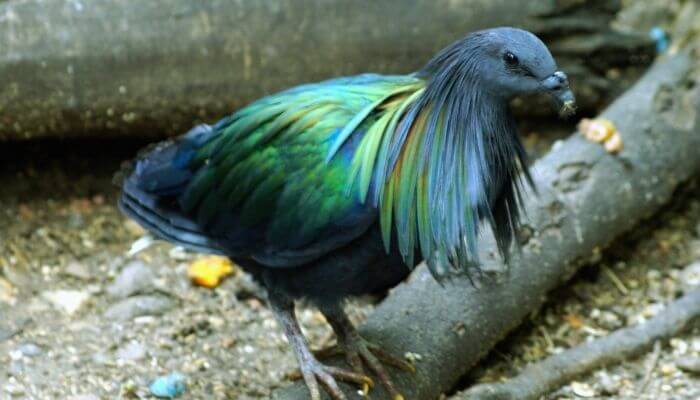
The location of these birds is so specific, in fact, that in 2017 headlines were made when a Nicobar pigeon was found in Australia and immediately quarantined by the Australian Department of Agriculture as part of their biosecurity measures.
Nicobar pigeons are able to inhabit a range of different settings from dry forests to rain forests to shrubland and mangroves.
As long as the general climate zone is tropical, Nicobar pigeons will be able to flourish.
They are also happy to move around from island to island and between islands and the mainland but they prefer the smaller, densely wooded and least-disturbed islands.
Status of the Nicobar Pigeon
As is the case with far too many unique and special species these days, the Nicobar pigeon is not as abundant in the wild.
On the official scale of status protection, the bird is categorised as being ‘Near Threatened’ by the International Union for Conservation of Nature (IUCN)

This might only be the second-highest level of danger on the scale, but when you learn that there are roughly only 1000 adult birds remaining in the world, it puts things into perspective.
There are also approximately 1600 Nicobar pigeons living in zoos and bird conservation environments within Europe (numbers in the USA are unknown but they are certainly within major zoos) which will, of course, help to prevent the species from becoming extinct entirely thanks to concentrated breeding programmes and expert research.
They breed quite successfully in captivity and have been known to live up to and beyond 30 years in captivity compared to 8-12 years in the wild.
Appearance
The Nicobar pigeon is classed as a large pigeon, typically measuring around 40cm (16 inches) in length and weighing 420-460 g (16oz).
It has a sturdy body with a small head, long legs and wings.
It is a very striking and unusual bird with drooping, iridescent plumage.
The bird has a grey head, the colour continuing down into the upper neck graduating to full plumage of vibrant metallic green and blue with distinctive mane-like copper hackles.
The Nicobar pigeon’s tail is a very short tail and is a brilliant pure white colour.

It is thought this might be a kind of “indicator light” visible to other pigeons because in flight, Nicobars form columns or single files.
The cere is a small, blackish mound at the upper base of the bill which is a hooked shape and the eyes have dark irises.
The bird has strong legs with feet of a dull red complexion and long yellow claws.
There is very little difference in the colour range across all Nicobar pigeons.
Females are typically slightly smaller than their male counterparts, with smaller bills and shorter hackles.
Colour differences can be found in browner underparts for a female.
Females have white irises whereas the males’ are brown.
If you see a Nicobar pigeon with a black tail and a general lack of the characteristic iridescence, then it will almost certainly be an immature pigeon that has yet to assume its full adult appearance.
Nicobar Pigeon Character
Due to their threatened status and rather distant and elusive nature, far less is known about the Nicobar pigeon than many other pigeon breeds.
What we do know, though, is that they like to move around in flocks during the daytime, and they will also roost together at night.
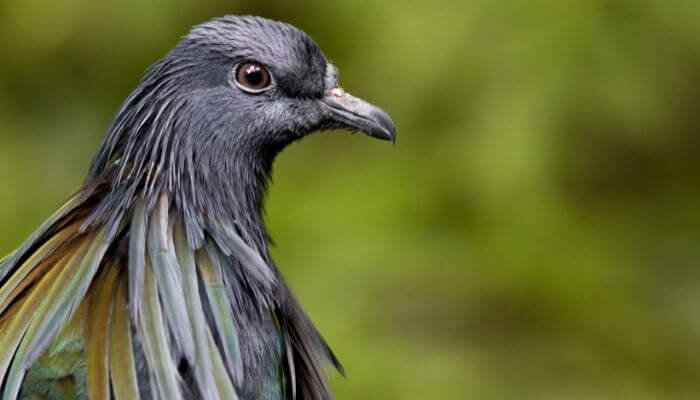
A typical flock will number around 80 birds.
They share a general pigeon and dove trait of not sipping when drinking water, but rather submerging their entire bill into the liquid and sucking it up instead.
The vocalisation of the Nicobar Pigeon is classed as being a classic ‘cooing’ sound. In general, however, it is not a very vocal bird.
They will sometimes make a sound that resembles something like a pig’s grunt when scared or threatened!
Diet
The diet of a Nicobar Pigeon isn’t too dissimilar to the diet of many other kinds of pigeon.
Typically, the everyday diet of a Nicobar Pigeon tends to include lots of different kinds of seeds, berries and also various small insects that might be found in their tropical environments.
In general, the Nicobar Pigeon spends a great deal of time on the floor of their forest, mangrove or shrubland, and as a result, they will feed on the floor as well.
This pigeon has a particularly strong gizzard!
This means that they are able to feed on really hard nuts that us weak humans are only able to eat after smashing them open.
Unfortunately, they are often hunted for their gizzard stones to be made into jewellery.
Nicobar Pigeon Mating and Breeding Behaviour
Sexual maturity is reached at 12 months old and they can breed all year round, laying up to 3 clutches a year.
At the start of the main breeding season which runs January to March, the birds retreat to the very small, wooded, uninhabited offshore islands (This behaviour is one of the risks to their existence because these islands get cleared of forests to make way for plantations).
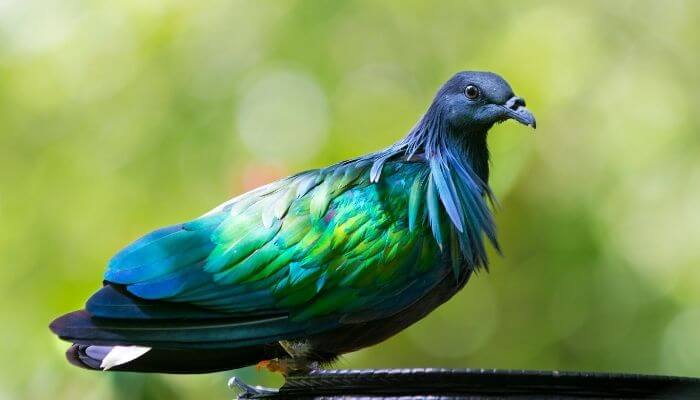
The Nicobar pigeon follows the same kinds of courtship patterns as most other doves and pigeons.
It is the male’s job to embark on a process of loud cooing and displaying their neck plumage for the females that they are interested in.
Once the courtship moves to a more advanced stage, the male will start to look like he is bowing for the female.
This can go on for a number of days in some cases and will then be followed by nest building.
The male always chooses the nesting site and then sets about gathering twigs and other nesting materials, and the female then uses these materials to actually build the nest.
The height at which a nest is built depends on how disturbed the area is.
Mostly, because they prefer quieter places, nests are at 1-2 m high but in disturbed areas they can be as high as 12 m.
Nicobar pigeons don’t mind sharing a tree with other nesting pairs.
Like many other species, the Nicobar pigeon is a monogamous bird that tends to mate for life but unlike most pigeons who have a typical clutch of two, the Nicobar lays one faintly blue-tinged egg.
Both male and female will share in the incubating duties for about two weeks after the chick has hatched, as it comes into the world almost completely naked!
The parents will keep the chicks as warm as possible for up to ten days, after which their feathers will start to grow.
Within a month, the young Nicobar pigeons are able to fend for themselves, but just like a large portion of young human adults that are ready to leave the nest, they tend to stick around with mom and dad for a little bit longer than they technically need to!
Taking Care of a Nicobar Pigeon
It’s a simple answer when it comes to thinking about what it takes to care for a Nicobar pigeon, and that answer is that you shouldn’t have one!
Due to its beautiful appearance and connection to the dodo, the Nicobar Pigeon is a very sought after exotic pet, but being classed as being threatened, the species is not available in most countries to be acquired as a pet.
The Nicobar’s presence on the CITES (Convention on International Trade in Endangered Species) makes it illegal for the bird to be traded in any context.
Unfortunately, we know that these laws will not always prevent the most immoral and adamant bird collectors, but we hope (no, we know!) that our readers are the kind of people who respect the threatened status and rules regarding the Nicobar pigeon.
